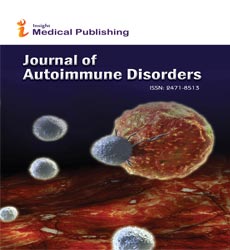Immune Checkpoints and Their Dysregulation in Autoimmunity
Allison Marco
Department of Virology and Immunology, Maria Curie-Sk?odowska University, Akademicka, Lublin, Poland
Published Date: 2025-02-28DOI10.21767/2471-8513.11.1.113
Corresponding author:
Allison Marco,
Department of Virology and Immunology, Maria Curie-SkÅ?odowska University, Akademicka, Lublin, Poland,
E-mail: marco.allison@mcsu.pl
Received date: February 01, 2025, Manuscript No. ipado-25-20466; Editor assigned date: February 03, 2025, PreQC No. ipado-25-2046(PQ); Reviewed date: February 15, 2025, QC No. ipado-25-20466; Revised date: February 22, 2025, Manuscript No. ipado-25-2046(R); Published date: February 28, 2025, DOI: 10.21767/2471-8513.11.1.113s
Citation: Marco A (2025) Immune Checkpoints and Their Dysregulation in Autoimmunity. J Autoimmune Disord Vol.11.No.1: 113.
Introduction
The immune system is finely tuned to balance protective responses against pathogens with tolerance to self-antigens. A critical component of this regulation is mediated by immune checkpoints molecular pathways that control the intensity and duration of immune activation. Immune checkpoints, such as programmed cell death protein-1 (PD-1), cytotoxic T-lymphocyteâ??associated antigen 4 (CTLA-4), and lymphocyte-activation gene 3 (LAG-3), function as inhibitory receptors that prevent overactivation of T cells and safeguard against autoimmunity. While these pathways are vital for maintaining self-tolerance, their dysregulation has been strongly implicated in the development and progression of autoimmune disorders. Understanding how immune checkpoint dysfunction contributes to autoimmunity offers valuable insights into pathogenesis and therapeutic innovation [1].
Description
Immune checkpoints act as brakes on T cell activation. CTLA-4, expressed on activated T cells and regulatory T cells (Tregs), competes with CD28 for binding to B7 molecules on antigen-presenting cells. This competition dampens co-stimulatory signaling and curtails T cell activation. Mutations or polymorphisms in CTLA4 have been linked to type 1 diabetes, systemic lupus erythematosus, and autoimmune thyroid disease, underscoring its importance in immune homeostasis. Similarly, PD-1, another inhibitory receptor, interacts with its ligands PD-L1 and PD-L2 to reduce T cell proliferation, cytokine secretion, and survival. Reduced PD-1 signaling, whether due to genetic variation or functional impairment, leads to prolonged T cell activation and tissue damage in conditions such as rheumatoid arthritis and multiple sclerosis [2].
Beyond CTLA-4 and PD-1, other checkpoints such as LAG-3, and TIGIT also contribute to immune regulation. Dysregulation in these pathways has been increasingly associated with autoimmune pathology. For example, reduced TIM-3 expression has been observed in patients with multiple sclerosis, while abnormalities in LAG-3 signaling have been linked to type 1 diabetes. These inhibitory receptors normally help maintain peripheral tolerance by promoting T cell exhaustion or enhancing regulatory cell function; when impaired, they allow autoreactive lymphocytes to expand unchecked [3].
The clinical significance of checkpoint dysregulation is also highlighted by the rise of immune checkpoint inhibitors in cancer therapy. While drugs targeting CTLA-4 and PD-1 have revolutionized oncology by boosting anti-tumor immunity, they often trigger immune-related adverse events (irAEs), which resemble autoimmune disorders. This provides real-world evidence that loss of checkpoint regulation can directly drive autoreactivity. These insights emphasize the delicate balance required between effective immune surveillance and prevention of autoimmunity [4,5].
Conclusion
Immune checkpoints are central to maintaining immune tolerance and preventing autoreactive responses. Their dysregulation whether due to genetic mutations, impaired signaling, or therapeutic inhibition can break self-tolerance and fuel autoimmune disease. Exploring the molecular mechanisms behind checkpoint dysfunction deepens our understanding of autoimmunity and opens new therapeutic avenues. Targeted strategies, such as enhancing checkpoint signaling or selectively restoring Treg function, hold promise for treating autoimmune disorders without broadly suppressing immunity. As research advances, immune checkpoints remain a critical intersection between immunological health, disease, and therapy.
Acknowledgment
None.
Conflict of Interest
None.
References
- Queirolo P, Boutros A, Tanda E, Spagnolo F, Quaglino P (2019). Immune-checkpoint inhibitors for the treatment of metastatic melanoma: a model of cancer immunotherapy. Semin Cancer Biol 59: 290-297. Academic Press.
Google Scholar Cross Ref Indexed at
- Sharma P, Allison JP (2015). The future of immune checkpoint therapy. Science 348: 56-61.
Google Scholar Cross Ref Indexed at
- Diaz-Montero CM, Finke J, Montero AJ (2014). Myeloid-derived suppressor cells in cancer: Therapeutic, predictive and prognostic implications. Semin Oncol 41: 174-184.
Google Scholar Cross Ref Indexed at
- Yao H, Wang H, Li C, Fang JY, Xu J (2018). Cancer cell-intrinsic PD-1 and implications in combinatorial immunotherapy. Front Immunol, 9, 1774.
Google Scholar Cross Ref Indexed at
- Yearley JH, Gibson C, Yu NI, Moon C, Murphy E, et al. (2017). PD-L2 expression in human tumors: relevance to anti-PD-1 therapy in cancer. Clin Cancer Res 23: 3158-3167.
Open Access Journals
- Aquaculture & Veterinary Science
- Chemistry & Chemical Sciences
- Clinical Sciences
- Engineering
- General Science
- Genetics & Molecular Biology
- Health Care & Nursing
- Immunology & Microbiology
- Materials Science
- Mathematics & Physics
- Medical Sciences
- Neurology & Psychiatry
- Oncology & Cancer Science
- Pharmaceutical Sciences
